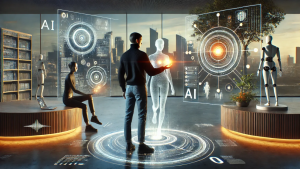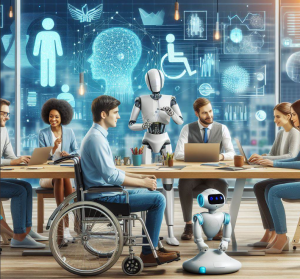
Introduction
In today’s digital world, making sure everyone can enjoy media and entertainment is very important. While many of us love watching movies, TV shows, listening to music, and playing video games, millions of people face difficulties because of disabilities. These challenges can make it hard or even impossible to access content. Thankfully, new technology, like artificial intelligence (AI), is helping to overcome these barriers and make media more inclusive.
AI is helping in many ways, such as providing subtitles and audio descriptions for people with hearing or vision impairments. It is changing how we experience entertainment. This article will look at how AI is improving accessibility in the entertainment industry, including the solutions it offers, the challenges it faces, and what the future holds.
The Rise of AI in Media and Entertainment Accessibility

AI-Powered Solutions for Accessibility

AI is making a big impact on accessibility by helping content creators automatically add features like captions, voice controls, and even sign language. These tools are not only making media easier to access but also saving time and money.
1. Automated Captioning and Subtitles
AI has improved a lot in creating captions and subtitles. In the past, captions were made by hand, which took a lot of time. Now, with AI, speech recognition technology can create captions quickly and accurately in real-time. This helps people with hearing impairments by showing the spoken words as text.
2. Voice-Controlled Navigation
AI-powered voice recognition helps people with physical disabilities or limited mobility use devices like TVs, smart speakers, or video game consoles. Voice assistants like Amazon Alexa, Google Assistant, and Apple’s Siri make it easier to control devices without needing a remote or buttons.
3. AI-Based Audio Descriptions
For people with vision impairments, AI-based audio descriptions are very helpful. These descriptions explain what’s happening visually, like what a character is doing or what the setting looks like. AI can now automatically create these descriptions, making the experience more accessible for users.
4. Real-Time Sign Language Interpretation
Sign language is important for people with hearing impairments. AI is now used to translate spoken language into sign language in real time. AI apps and software can turn speech into sign language using avatars, making content more inclusive for deaf and hard-of-hearing people.
Challenges in Implementing AI for Accessibility

Even though AI has great potential to improve accessibility, there are still some challenges to overcome.
1. Accuracy and Quality of AI Transcription
AI-generated captions have come a long way, but they’re not always perfect. Accents, background noise, and technical terms can confuse AI, leading to mistakes in the captions. This can affect the experience for people who rely on them.
2. Ethical Concerns
There are also concerns about the ethical use of AI for accessibility. For example, AI-generated audio descriptions may not always be accurate and might miss important details. Content creators must make sure these AI features meet high-quality standards.
3. Cost of Integration
While AI can lower costs over time, adding AI tools to media platforms can be expensive at first. Small content creators might not be able to afford these technologies, which could limit how many people benefit from these improvements.
AI’s Role in Enhancing Media Accessibility: The Bigger Picture

AI’s impact on accessibility goes beyond just helping people with disabilities. It’s changing the whole media and entertainment world to be more inclusive. Here are some of the wider effects of AI-driven accessibility.
1. Reaching a Bigger Audience
By using AI for accessibility, content creators can reach more people, including those with disabilities. For example, tools like speech-to-text help people who are deaf or hard of hearing enjoy movies, TV shows, and music, growing the potential audience.
2. Enhancing User Experience
AI accessibility features improve the experience for everyone, not just those with disabilities. Features like voice commands, personalized recommendations, and language translation make it easier for all users to enjoy media.
3. Legal and Social Effects
As inclusivity becomes more important, there are also new legal rules. Many governments are now requiring accessible content on media platforms, pushing companies to adopt AI solutions. AI makes it simpler and faster to meet these legal requirements.
The Future of Accessibility in Media and Entertainment

Looking ahead, AI’s role in making media accessible will only grow. As AI becomes smarter, we can expect more helpful and personalized features. For example, AI could soon provide accessibility options that adapt to each user’s personal needs, creating a unique experience for everyone. Also, as AI learns from more diverse language, culture, and disability data, it will get better at serving a wide range of people.
Another exciting possibility is using AI in virtual reality (VR) and augmented reality (AR). Combined with AI, these technologies could create immersive experiences that are accessible to people with disabilities. Imagine a VR game where users with limited mobility can explore the virtual world through voice or eye control, or a VR movie that automatically adjusts audio and visuals to suit each user’s needs.
Analysis Table: Key AI Accessibility Features and Their Impact
| AI Feature | Impact on Accessibility | User Benefits | Challenges |
|---|---|---|---|
| Automated Captioning | Provides real-time captions for spoken words | Helps the hearing impaired follow the dialogue | Accuracy issues with accents or background noise |
| Voice-Controlled Navigation | Allows users to control devices with voice commands | Benefits people with physical disabilities | Reliance on clear and accurate voice recognition |
| AI-Based Audio Descriptions | Narrates visual elements for blind or visually impaired users | Improves content understanding for the visually impaired | Quality varies; sometimes lacks detailed descriptions |
| Real-Time Sign Language Translation | Translates speech to sign language in real-time | Provides accessibility for the deaf or hard of hearing | Still in development, accuracy can be an issue |
Comparative Table: Traditional vs. AI-Powered Accessibility Features
| Feature | Traditional Approach | AI-Powered Approach | Pros of AI-Powered Approach | Cons of AI-Powered Approach |
|---|---|---|---|---|
| Captioning/Subtitling | Manually created by transcribers | Automated via speech recognition software | Faster, cheaper, real-time generation | Accuracy may vary, limited by AI’s learning capacity |
| Audio Descriptions | Narrated by human voice actors | Automatically generated via AI algorithms | More scalable, immediate availability | May lack nuances and detailed description |
| Sign Language Translation | Performed by human interpreters | Real-time translation by AI avatars | Can be done in real time, more accessible | Quality and accuracy can be inconsistent |
| Voice-Control Navigation | Remote or physical interaction with devices | AI-based voice control (e.g., Alexa, Siri) | Hands-free control, accessible for disabled users | Reliant on voice recognition accuracy |
Conclusion: Embracing the Future of Inclusive Media
AI is proving to be a game-changer in making media and entertainment more accessible. From providing automatic captions to voice controls and sign language translation, AI is unlocking a new era of inclusivity for individuals with disabilities. While challenges remain, the potential benefits of AI in this space are immense. As the technology continues to evolve, we can look forward to a more inclusive and accessible media landscape for everyone.










